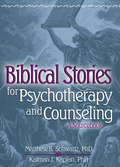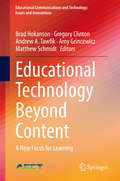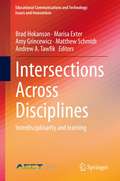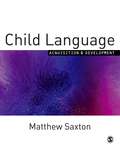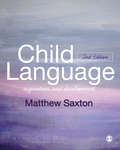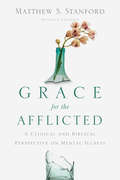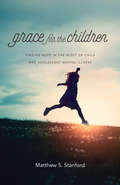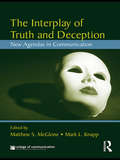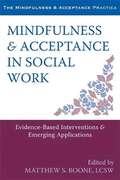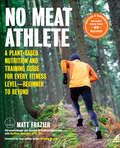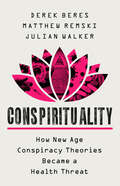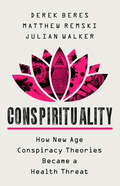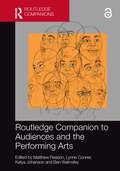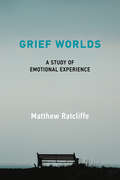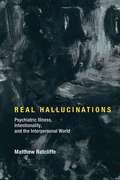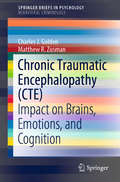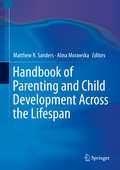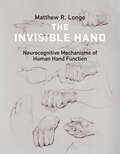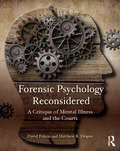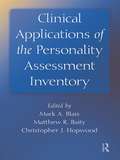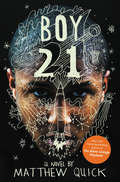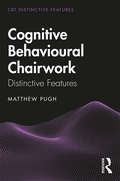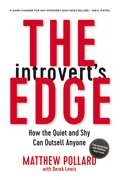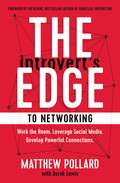- Table View
- List View
Biblical Stories for Psychotherapy and Counseling: A Sourcebook
by Matthew Schwartz Kalman KaplanIntegrate Biblical spirituality into psychotherapy and examine centuries-old answers to modern psychological questions! The Joint Commision on the Accreditation of Hospitals now mandates taking spiritual assessments of all patients. This book is devoted to helping therapists employ Biblical spirituality in the actual treatment program. Biblical Stories for Psychotherapy and Counseling: A Sourcebook organizes the wisdom of the Old Testament into episodes that can shed light on specific psychological issues. From the familiar to the obscure, these stories can help us better understand self-esteem, loyalty and obligations, decision making, temptation, anger, morality, various disorders, family dynamics, support systems, developmental issues, recovery issues, aging, suicidal behavior, and more. From the authors: "As brilliant and as penetrating as Freud's insights are, they are limited in the sense that Freud relied heavily on Greek myth and literature for his models and ideas. His view of man was in many ways that of the Greeks-a view that concentrated on the pathological underside of man and on the bedrock of his developmental problems. The Greeks could never really shake the sense of doom, the foreboding and the fatalism that led so many great figures in Greek literature and in real life Greek history to depression and, in a surprising number of cases, to suicide. In contrast, the focus of the Bible is far more optimistic; depression can be successfully dealt with, and suicide is a sad error that should be-and usually can be-avoided. It encourages people to hope and teaches that day-to-day human effort has a purpose and meaning and that heroism is not a fair or useful aim for man to set for himself. The Bible offers the hope of filling every moment of human life with greater meaning and feeling. "New solutions to mental health problems are always welcome. Ours is a new approach, yet a very old one. We present stories that offer a vast treasure of knowledge and wisdom about the way people think and act, and why they do so. The stories are drawn from the Hebrew Bible, a compendium whose latest books are already twenty-four hundred or so years old. Yet, through all those centuries, the basic story of man's searching and yearning has changed little. We shall concentrate on the psychological meaning of these narratives and what they tell us about how their characters dealt with challenges of family, handicap, depression, and more." You'll also find information drawn from modern clinical research that parallels the Biblical narratives. The wisdom gained from these ancient stories is applied to help people gain self-understanding and deal with their own situations today. For psychotherapists, these Biblical foundation stories can be used as a basis for integrating spirituality into psychotherapy. The story of Moses, who overcame a speech problem, can be applied to the problems of a Midwestern college student, and the account of David and Goliath can help a businessman overcome his fears of "lack of macho." A small sample of the Bible stories-and their clinical implications-that you'll find in this volume: the foundation of self-esteem: Saul the courage to emigrate: Abraham assuming responsibility for one's self: Lot's wife focusing on one's main aim: Sarah and Hagar dealing with commandments: Abraham and Isaac dealing with temptations: Adam and Eve drunkenness and disrespect: Noah reciprocity between generations: Naomi and Ruth amoral intellectualism: Balaam aging: Ecclesiastes dealing with disability: Moses and Aaron abandonment: David protected regression: Jonah Biblical Stories for Psychotherapy and Counseling: A Sourcebook will become a well-used reference in your professional/teaching collection. These Biblical stories will be helpful to therapists, cle
Educational Technology Beyond Content: A New Focus for Learning (Educational Communications and Technology: Issues and Innovations)
by Brad Hokanson Gregory Clinton Andrew A. Tawfik Amy Grincewicz Matthew SchmidtThis book is the outcome of a research symposium sponsored by the Association for Educational Communications and Technology [AECT]. Consisting of twenty-four chapters, including an introduction and conclusion, it argues that informational content should not be the main element of education, and that to provide more for learners, it is necessary to go beyond content and address other skills and capabilities. It also discusses the false premise that learning is complete when the information is known, not when learners seek more: their own directions, answers, and ideas. The authors assert that the ability to synthesize, solve problems and generate ideas is not based on specific content, although education often focuses solely on teaching content. Further, they state that content can be separated from the learning process and that instructional design and educational technology must be about the skills, habits, and beliefs to be learned.
Intersections Across Disciplines: Interdisciplinarity and learning (Educational Communications and Technology: Issues and Innovations)
by Brad Hokanson Andrew A. Tawfik Amy Grincewicz Matthew Schmidt Marisa ExterThis volume is the result of the annual Summer research symposium sponsored by the Association for Educational Communications and Technology (AECT). The twenty-two chapters in this volume seek to examine how learning and the design of instruction is interdisciplinary and connective in terms of research and practice. The book is generally divided into three areas: Theory, Research, and Application. This framework shaped the authors’ interactions, discussions, and the informal context of the symposium. Writings are included on multiple levels including research and practice on learning across disciplines, including instructional design and how design thinking is inherently interdisciplinary. How learning is designed for general audiences or for purposely integrated educational experiences has also been examined.
Child Language
by Matthew SaxtonSaxton (education, U. of London) presents a textbook for a graduate or undergraduate course primarily for students of psychology who are interested in child language. There being no reason whatsoever for psychology major to have had any training in linguistic theory, he assumes nothing, and explains even such terms as verb and noun. He covers landmarks in the landscape of child language, whether animals can acquire human language, the critical-period hypothesis, input and interaction, language in the first year, the developing lexicon, the acquisition of morphology, linguistic nativism, the usage-based approach, and nature and nurture. Annotation ©2011 Book News, Inc. , Portland, OR (booknews. com)
Child Language: Acquisition and Development
by Matthew SaxtonThis is the best book on the market for taking students from ‘how children acquire their first language’ to the point where they can engage with key debates and current research in the field of child language. No background knowledge of linguistic theory is assumed and all specialist terms are introduced in clear, non-technical language. It is rare in its balanced presentation of evidence from both sides of the nature–nurture divide and its ability to make this complicated topic engaging and understandable to everyone. This edition includes Exercises to foster an understanding of key concepts in language and linguistics A glossary of key terms so students can always check back on the more difficult terms Suggestions for further reading including fascinating TED Talks that bring the subject to life Access to Multiple Choice Quizzes and other online resources so students can check they've understood what they have just read
Child Language: Acquisition and Development
by Matthew SaxtonThis is the best book on the market for taking students from ‘how children acquire their first language’ to the point where they can engage with key debates and current research in the field of child language. No background knowledge of linguistic theory is assumed and all specialist terms are introduced in clear, non-technical language. It is rare in its balanced presentation of evidence from both sides of the nature–nurture divide and its ability to make this complicated topic engaging and understandable to everyone. This edition includes Exercises to foster an understanding of key concepts in language and linguistics A glossary of key terms so students can always check back on the more difficult terms Suggestions for further reading including fascinating TED Talks that bring the subject to life Access to Multiple Choice Quizzes and other online resources so students can check they've understood what they have just read
Grace for the Afflicted: A Clinical and Biblical Perspective on Mental Illness
by Matthew S. StanfordGrace for the Afflictedbipolar disorderstrauma- and stressor-related disordersdementiacerebrovascular accidents (stroke)traumatic brain injurysuicidea holistic approach to recoverymental health and the church
Grace for the Children: Finding Hope in the Midst of Child and Adolescent Mental Illness
by Matthew S. StanfordThe church's response to child and adolescent mental health disorders has too often been characterized by fear and misinformation rather than grace or wisdom.Grace for the Childrenautism spectrum disorderattention deficit hyperactivity disorderdisruptive behavior disordersdepressionbipolar disordersanxietyposttraumatic stress disorderobsessive compulsive and related disorderseating disordersGrace for the Children
The Interplay of Truth and Deception: New Agendas in Theory and Research (New Agendas in Communication Series)
by Mark L. Knapp Matthew S. McGloneDuring the past 30 years, there have been a steadily increasing number of scientific and popular publications dealing with lying and deception. Questions about the extent to which public officials are deceptive are standard fare in current magazines and newspapers. This volume aims to present on a more precise conceptualization of this phenomenon, manifested in some well-known constructions like spin, hype, doublespeak, equivocation, and contextomy (quoting out of context). The contents of the volume have been generated for the New Agendas symposium at the University of Texas College of Communication, and all the authors are young, leading-edge researchers offering innovative perspectives and explorations of lying and deception in various contexts. This volume will appeal to scholars, researchers, and advanced/graduate students in communication, media, and psychology. It is written to the level of advanced undergraduates, and it is appropriate for use in courses covering lying and deception.
Mindfulness and Acceptance in Social Work: Evidence-Based Interventions and Emerging Applications (Context Press Mindfulness And Acceptance Practica Ser.)
by Matthew S. BooneSocial work focuses on serving the most vulnerable members of society, and social workers must often address the contextual forces that contribute to human problems. Mindfulness and acceptance are powerful tools for this practice. By offering interventions like dialectical behavior therapy (DBT), mindfulness-based stress reduction (MBSR), and acceptance and commitment therapy (ACT), social workers can help their clients become more aware and take effective action. <p><p>In Mindfulness and Acceptance in Social Work, editor and social worker Matthew S. Boone brings together contributions from emerging voices in social work, such as Elana Rosenbaum, Yuk-Lin Renita Wong, and Diana Coholic, along with ACT pioneers Kirk Strosahl, Patricia Robinson, and others. This book focuses not only on mindfulness-based interventions for direct practice, but also on the intersection of mindfulness and social work education, cultural diversity, and macro social work. It includes a framework for moving past culturally-informed biases, and for how to best utilize mindfulness interventions for both individuals and the community at large.
No Meat Athlete: A Plant-Based Nutrition and Training Guide for Every Fitness Level—Beginner to Beyond
by Matthew Ruscigno Matt FrazierA vegan ultramarathoner “provides the roadmap to wellness and performance no matter where the journey takes you” (Scott Jurek, world-renowned Ultramarathon champion and New York Times–bestselling author).Veganism is taking off in the sports world. The lifestyle has been adopted by Olympians, body builders, and boxers, as well as top athletes in the NBA and NFL. Hollywood is on board, too. James Cameron (director of Avatar and Titanic) has produced a film on the topic called The Gamechangers, which follows vegan athletes, including Arnold Schwarzenegger, US Olympian Kendrick James Farris, and surfer Tia Blanco. In No Meat Athlete, author, blogger, and hundred-mile ultramarathoner Matt Frazier will show you the many benefits to embracing a plant-based athletic lifestyle, including: ·Weight loss, which often leads to increased speed ·Easier digestion and faster recovery after workouts ·Improved energy levels to help not only athletic performance, but your daily life ·Reduced impact on the planet In this revised and updated edition, you’ll also find new recipes, advice, and an all-new twelve-week strength training plan designed to improve your overall fitness. Section I of the book provides practical advice for transitioning to a plant-based lifestyle, while ensuring you are getting all the nutrition you need. In Section II, Matt delivers training manuals of his own design for runners of all ability levels and ambitions, including tips for creating healthy habits, improving performance, and avoiding injuries. No Meat Athlete is your road map to top-notch performance, the plant-based way!“Matt Frazier presents the tools and information . . . in a way that is downright approachable, leaving his readers energized with a sense of possibility.” —Brendan Brazier, Ultramarathon champion, professional Ironman triathlete, and author of Thrive
Conspirituality: How New Age Conspiracy Theories Became a Health Threat
by Julian Walker Derek Beres Matthew RemskiConspirituality takes a deep dive into the troubling phenomenon of influencers who have curdled New Age spirituality and wellness with the politics of paranoia—peddling vaccine misinformation, tales of child trafficking, and wild conspiracy theories. In the early days of the COVID-19 pandemic, a disturbing social media trend emerged: a large number of yoga instructors and alt-health influencers were posting stories about a secretive global cabal bent on controlling the world&’s population with a genocidal vaccine. Instagram feeds that had been serving up green smoothie recipes and Mary Oliver poems became firehoses of Fox News links, memes from 4chan, and prophecies of global transformation. Since May 2020, Derek Beres, Matthew Remski and Julian Walker have used their Conspirituality podcast to expose countless facets of the intersection of alt-health practitioners with far-right conspiracy trolls. Now this expansive and revelatory book unpacks the follies, frauds, cons and cults that dominate the New Age and wellness spheres and betray the trust of people who seek genuine relief in this uncertain age. With analytical rigor and irreverent humor, Conspirituality offers an antidote to our times, helping readers recognize wellness grifts, engage with loved ones who've fallen under the influence, and counter lies and distortions with insight and empathy.
Conspirituality: How New Age Conspiracy Theories Became a Public Health Threat
by Julian Walker Derek Beres Matthew RemskiConspirituality takes a deep dive into the troubling phenomenon of influencers who have curdled New Age spirituality and wellness with the politics of paranoia—peddling vaccine misinformation, tales of child trafficking, and wild conspiracy theories.In the early days of the COVID-19 pandemic, a disturbing social media trend emerged: a large number of yoga instructors and alt-health influencers were posting stories about a secretive global cabal bent on controlling the world&’s population with a genocidal vaccine. Instagram feeds that had been serving up green smoothie recipes and Mary Oliver poems became firehoses of Fox News links, memes from 4chan, and prophecies of global transformation.Since May 2020, Derek Beres, Matthew Remski and Julian Walker have used their Conspirituality podcast to expose countless facets of the intersection of alt-health practitioners with far-right conspiracy trolls. Now this expansive and revelatory book unpacks the follies, frauds, cons and cults that dominate the New Age and wellness spheres and betray the trust of people who seek genuine relief in this uncertain age. Each of the three authors has witnessed firsthand the use of fear-based political agendas to manipulate the human desire for spiritual fulfillment. They throw a spotlight on the telltale signs of cult dynamics and expose how influencers have stoked suspicion of public health initiatives. And they show how charlatans and pseudo-doctors encourage their followers to oppose mainstream advice as a form of spiritual quest. With analytical rigor and flashes of irreverent humor, Conspirituality offers an antidote to our times, helping readers recognize wellness grifts, engage with loved ones who've fallen under the influence, and counter lies and distortions with insight and empathy.
Routledge Companion to Audiences and the Performing Arts (Audience Research)
by Matthew ReasonThe Routledge Companion to Audiences and the Performing Arts represents a truly multi-dimensional exploration of the inter-relationships between audiences and performance. This study considers audiences contextually and historically, through both qualitative and quantitative empirical research, and places them within appropriate philosophical and socio-cultural discourses. Ultimately, the collection marks the point where audiences have become central and essential not just to the act of performance itself but also to theatre, dance, opera, music and performance studies as academic disciplines. This Companion will be of great interest to academics, researchers and postgraduates, as well as to theatre, dance, opera and music practitioners and performing arts organisations and stakeholders involved in educational activities.
Grief Worlds: A Study of Emotional Experience
by Matthew RatcliffeA wide-ranging philosophical exploration of what it is to experience grief and what this tells us about human emotional life.Experiences of grief can be bewildering, disorienting, and isolating; everything seems somehow different, in ways that are difficult to comprehend and describe. Why does the world as a whole look distant, strange, and unfamiliar? How can we know that someone is dead, while at the same time find this utterly unfathomable, impossible? Grief Worlds explores a host of philosophical questions raised by grief, showing how philosophical inquiry can enhance our understanding of grief and vice versa.Throughout the book, Matthew Ratcliffe focuses on the phenomenology of grief: what do experiences of grief consist of, how are they structured, and what can they tell us about the nature of human experience more generally? While acknowledging the diversity of grief, Ratcliffe sets out to identify its common features. Drawing extensively on first-person accounts, he proposes that grief is a process that involves experiencing, comprehending, and navigating a pervasive disturbance of one&’s experiential world. Its course over time depends on ways of experiencing and relating to other people, both the living and the dead. Along with its insights into the workings of grief, the book provides us with a broader philosophical perspective for thinking about human emotional experience.
Real Hallucinations: Psychiatric Illness, Intentionality, and the Interpersonal World (Philosophical Psychopathology)
by Matthew RatcliffeA philosophical account of the structure of experience and how it depends on interpersonal relations, developed through a study of auditory verbal hallucinations and thought insertion.In Real Hallucinations, Matthew Ratcliffe offers a philosophical examination of the structure of human experience, its vulnerability to disruption, and how it is shaped by relations with other people. He focuses on the seemingly simple question of how we manage to distinguish among our experiences of perceiving, remembering, imagining, and thinking. To answer this question, he first develops a detailed analysis of auditory verbal hallucinations (usually defined as hearing a voice in the absence of a speaker) and thought insertion (somehow experiencing one's own thoughts as someone else's). He shows how thought insertion and many of those experiences labeled as “hallucinations” consist of disturbances in a person's sense of being in one type of intentional state rather than another.Ratcliffe goes on to argue that such experiences occur against a backdrop of less pronounced but wider-ranging alterations in the structure of intentionality. In so doing, he considers forms of experience associated with trauma, schizophrenia, and profound grief.The overall position arrived at is that experience has an essentially temporal structure, involving patterns of anticipation and fulfillment that are specific to types of intentional states and serve to distinguish them phenomenologically. Disturbances of this structure can lead to various kinds of anomalous experience. Importantly, anticipation-fulfillment patterns are sustained, regulated, and disrupted by interpersonal experience and interaction. It follows that the integrity of human experience, including the most basic sense of self, is inseparable from how we relate to other people and to the social world as a whole.
Chronic Traumatic Encephalopathy: Impact on Brains, Emotions, and Cognition (SpringerBriefs in Psychology)
by Charles J. Golden Matthew R. ZusmanThe term chronic traumatic encephalopathy (CTE) has recently gained a significant amount of media coverage. However, a large proportion of the information disseminated through the media pertaining to the etiology, neuropathology, and clinical manifestations of CTE are not corroborated by empirical research, and are disputed by prominent researchers who study sports related head injury. This book reviews the existing literature pertaining to these components of CTE and includes unique case studies of several retired NFL players that received a comprehensive neuropsychological battery from a board certified neuropsychologist, among other populations. It investigates the claim that CTE causes depression, violent behavior, and an increased risk for suicide by providing an in depth discussion using empirical data. Highlighting the importance of adhering to post concussion protocol and appreciating the long-term consequences of repeated head trauma, this unique review of the current research on CTE will be useful to students and professionals in psychology and neurology.
Handbook of Parenting and Child Development Across the Lifespan
by Matthew R. Sanders Alina MorawskaThis handbook presents the latest theories and findings on parenting, from the evolving roles and tasks of childrearing to insights from neuroscience, prevention science, and genetics. Chapters explore the various processes through which parents influence the lives of their children, as well as the effects of parenting on specific areas of child development, such as language, communication, cognition, emotion, sibling and peer relationships, schooling, and health. Chapters also explore the determinants of parenting, including consideration of biological factors, parental self-regulation and mental health, cultural and religious factors, and stressful and complex social conditions such as poverty, work-related separation, and divorce. In addition, the handbook provides evidence supporting the implementation of parenting programs such as prevention/early intervention and treatments for established issues. The handbook addresses the complementary role of universal and targeted parenting programs, the economic benefits of investment in parenting programs, and concludes with future directions for research and practice. Topics featured in the Handbook include: · The role of fathers in supporting children’s development. · Developmental disabilities and their effect on parenting and child development. · Child characteristics and their reciprocal effects on parenting. · Long-distance parenting and its impact on families. · The shifting dynamic of parenting and adult-child relationships. · The effects of trauma, such as natural disasters, war exposure, and forced displacement on parenting. The Handbook of Parenting and Child Development Across the Lifespan is an essential reference for researchers, graduate students, clinicians, and therapists and professionals in clinical child and school psychology, social work, pediatrics, developmental psychology, family studies, child and adolescent psychiatry, and special education.
The Invisible Hand: Neurocognitive Mechanisms of Human Hand Function
by Matthew R. LongoHow the &“invisible hand&” of the nervous system makes the human hand such an evolutionary success.The hand has a central role in both human evolution and cultural development—in our descent and in our ascent. It is, Immanuel Kant said, &“the visible part of the brain.&” It is the invisible that concerns Matthew Longo in The Invisible Hand, a wide-ranging, deftly written account of the neural and cognitive mechanisms that have made a seemingly ordinary physical appendage an extraordinary tool in the evolution of humanity.The hand has been the focus of an enormous amount of research from a dizzying range of disciplines, from anatomy, psychology, and neuroscience to evolutionary biology and archaeology. With the concept of the invisible hand, Longo integrates and contextualizes the findings from these disparate fields to show how the neurocognitive mechanisms that comprise the invisible hand are central to understanding a wide array of phenomena, including basic sensory and motor function, space perception, gesture, and even the self. More generally, he contends that the extraordinary abilities of the hand arise precisely from the complementary nature and tight integration of the visible and invisible hands—a proposition that leads deep into topics as diverse as haptics, tool use, handedness, phantom limbs, and evolution. His work elucidates and significantly expands a key chapter of the story of human evolution and culture as manifested in the human hand.
Forensic Psychology Reconsidered: A Critique of Mental Illness and the Courts
by David Polizzi Matthew R. DraperForensic psychology is where psychology meets the criminal justice system. An understanding of the intersection of criminal law and psychological issues relating to criminal responsibility is critical for criminal justice students. This accessible text focuses on the criminal law implications of forensic psychology as it relates to topics such as competency to stand trial, state of mind at the time of the crime, suicide by cop, and involuntary psychiatric medication administered in custody. Unlike more traditional texts on this topic, which are primarily concerned with the clinical practice of forensic psychology, this book focuses on critical thinking as it relates to these topics. Each chapter presents a critical analysis of the topic under study, going beyond merely identifying the legal parameters of criminal responsibility to explore the ethical, philosophical, and theoretical foundations of that concept.
Clinical Applications of the Personality Assessment Inventory
by Mark A. Blais Christopher J. Hopwood Matthew R. BaityClinical Applications of the Personality Assessment Inventory demonstrates the broad clinical utility of this modern multi-scale self-report measure of psychological functioning. By bringing together leading experts in psychological assessment from diverse applied settings, the book illustrates the impressive range of current Personality Assessment Inventory (PAI) applications while providing recommendations for expanding the instrument’s research base and clinical use. Many authors also present population specific PAI reference data. In this timely volume, experts from specialized areas of psychological assessment integrate the relevant research with their extensive clinical knowledge of the PAI, making this a valuable text for practitioners, students, and researchers.
Boy21
by Matthew QuickFrom Matthew Quick, the author of The Silver-Linings Playbook, comes a powerful young adult novel about basketball, outer-space and friendship. <p><p> You can lose yourself in repetition--quiet your thoughts; I learned the value of this at a very young age. <p> Basketball has always been an escape for Finley. He lives in broken-down Bellmont, a town ruled by the Irish mob, drugs, violence, and racially charged rivalries. At home, his dad works nights, and Finley is left to take care of his disabled grandfather alone. He's always dreamed of getting out someday, but until he can, putting on that number 21 jersey makes everything seem okay. <p> Russ has just moved to the neighborhood, and the life of this teen basketball phenom has been turned upside down by tragedy. Cut off from everyone he knows, he won't pick up a basketball, but answers only to the name Boy21--taken from his former jersey number. <p> As their final year of high school brings these two boys together, a unique friendship may turn out to be the answer they both need.
Cognitive Behavioural Chairwork: Distinctive Features (CBT Distinctive Features)
by Matthew PughCognitive Behavioural Chairwork: Distinctive Features provides a practical, accessible, and concise introduction to both the theory and practice of chairwork, one of the most powerful and exciting methods of intervention in cognitive behavioural therapy (CBT), and is the first book to synthesise its many applications in CBT and allied therapies.Part of the popular 'CBT Distinctive Features' series, this book contains a wealth of effective experiential procedures for working with automatic thoughts, emotions, behaviours, core beliefs, ambivalence, strengths, well-being, and cognitive processes such as worry and self-criticism. Readers will also learn how chairwork is applied in other areas, such as clinical supervision and associated psychotherapeutic approaches including compassion focused therapy, schema therapy, positive psychotherapy, and motivational interviewing. Techniques are presented in an easy-to-understand format and illustrated using clinical examples and therapy transcripts. The result is a comprehensive guide which demystifies chairwork and places it at the heart of CBT’s continued evolution.Created for practising clinicians, researchers, and training therapists, Cognitive Behavioural Chairwork: Distinctive Features will appeal to both individuals who are new to chairwork and those who are familiar with its techniques.
The Introvert's Edge: How the Quiet and Shy Can Outsell Anyone
by Derek Lewis Matthew PollardAn introvert? Great at sales? YES.Sales is a skill anyone can learn and master — and introverts are especially good at it once they learn how to leverage their natural strengths.Introverts aren’t comfortable with traditional tactics like aggressively pushing a product or talking over a customer’s objections. That’s the beauty of The Introvert’s Edge: it doesn’t focus on the sale itself but on a sales system that helps introverts feel sincere instead of sales-y. Powerful and practical, the book reveals how to:Find natural confidencePrepare for every situationPresent your value so that customers want to buySidestep objectionsJudge when the customer’s ready to buyAsk for the sale — without askingContinually adapt and improveProfit from a process that doesn’t rely on personalityEnjoy salesWith stories of introverted entrepreneurs, salespeople, and business owners who went from stagnant to success, The Introvert’s Edge shows you how to succeed in sales — without changing who you are.
The Introvert’s Edge to Networking: Work the Room. Leverage Social Media. Develop Powerful Connections (The Introvert’s Edge Series)
by Matthew PollardOne of the biggest myths that plagues the business world today is that our ability to network depends on having the &“gift-of-gab.&” You don&’t have to be outgoing to be successful at networking. You don&’t have to become a relentless self-promoter. In fact, you don&’t have to act like an extrovert at all.The truth is that when introverts are armed with a plan that lets them be their authentic selves, they make the best networkers.Matthew Pollard, an introvert himself, draws on over a decade of research and real-world examples to provide an actionable blueprint for introverted networking. A sequel to Pollard&’s international bestseller The Introvert&’s Edge: How the Quiet and Shy Can Outsell Anyone, this book masterfully confronts the stigma around the so-called extroverted arena of networking.In The Introvert&’s Edge to Networking, you&’ll discover how to:Overcome your fear and discomfort when networkingTurn networking into a repeatable systemLeverage your innate introverted strengthsTarget and connect with top influencersLeverage the power of virtual and social networkingThe introvert&’s roadmap to success doesn&’t look like the extroverts, we&’re different and we should embrace that.Whether you&’re a small business owner struggling to make a living or a professional who&’s hit a career plateau, The Introvert&’s Edge to Networking is your path to a higher income and a rolodex of powerful connections.
